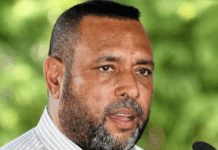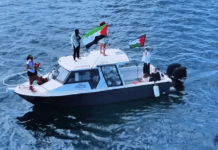
Cryptocurrencies are a controversial phenomenon that have risen from a technical experiment, with zero monetary value, to an industry with a combined market capitalisation of US$225 billion – after shedding more than $30 billion this week. Their future is uncertain, with analysts ranging from enthusiasts to sceptics, but James Halpin of Asia Pacific Journalism profiles a bold scheme for Papua New Guinea.
Cryptocurrencies give developing nations the ability to bring payment systems to people in remote locations, bypassing commercial banks. Torokina, a cryptocurrency in development out of Papua New Guinea, will do just that, says creator David Eri.
Eri, an employee at Oilsearch Limited, is in the process of securing funding to launch Torokina.
After attending the Kumul Game Changers incubator, which brought together startups from Papua New Guinea, Fiji, Tonga and Samoa, and learning how to start a start-up with little to no capital, Eri was selected out of that cohort.
![]() Sponsored by Oilsearch Limited to attend Draper University through its Citizen Development Programme, which aims to give high-performing Papua New Guinean citizens pathways into leadership roles within the company, Eri was able to present Torokina to Silicon Valley entrepreneurs.
Sponsored by Oilsearch Limited to attend Draper University through its Citizen Development Programme, which aims to give high-performing Papua New Guinean citizens pathways into leadership roles within the company, Eri was able to present Torokina to Silicon Valley entrepreneurs.
He says he received positive feedback.
“I got excellent feedback and have a ways to proceed so I have been working on my project since then,” he says.
Now back in Papua New Guinea, Eri faces the daunting challenge of getting his dream off the ground.
Kina weakness
One of the big issues Eri wants to solve is the weakness in the kina’s value overseas.
“When Papua New Guineans take K1000 overseas they usually get US$250 or A$350. Our kina loses 75 percent of its value as soon as it leaves our shores.”
One way to ensure the stability and attractiveness of Torokina is to take advantage of Papua New Guinean’s natural endowment and peg Torokina to the price of gold.
“One thing we are abundantly blessed with is our natural resources, particularly gold. PNG accounts for 0.7 percent of the world’s gold. Relatively minor but this adds up to US$2.1 billion extracted a year,” he says.
“The aim of Torokina was to combine our natural resources and combine it with current technology to create a gold backed cryptocurrency that performs on par with major currencies like the USD, AUD, JPY, GBP etc in trade and commerce.
“And by pegging the cryptocurrency with a valuable commodity hedges the volatility of the cryptomarket.”
A gold-backed cryptocurrency would work by x amount of the cyrptocurrency representing one unit of gold. If the cryptocurrency increases in price, then more currency is needed to buy the same amount of gold. If the cryptocurrency doesn’t increase in value, then it is unlikely to go below the price of gold.
Gold buying reserves
However, backing the cryptocurrency to gold does force Torokina into actually having to buy or have reserves to buy the gold, forcing purchasers to put their faith in Torokina’s ability to be able to survive a run on selling Torokina.
Gold-backed cryptocurrency has precedents though, and has been done before with the cryptocurrency E-gold emerging as the forerunner in 1995.
Remittances are a minor part of PNG’s GDP at just under US$3million, according to the World Bank. One reason for this is the 10 percent fee that the government takes from remittances.
Using blockchain technology, Torokina would be able to remove the fee barrier for Papua New Guinean nationals sending money back to PNG. This would also remove the remittance firm’s cut and increase income received by families in PNG, of which 75 percent live on subsistence.
Cryptocurrencies give criminals another avenue with which they can move money. However, because of the blockchain they are completely anonymous.
Eri recognises this negative view of a cryptocurrency in a developing country that is prone to money laundering.
Cryptocurrency dangers
A 2014 US Department of Homeland Security report outlined the dangers of cryptocurrencies.
“Cryptocurrencies offer cyber-criminals, corrupt officials, transnational criminal organisations, and foreign terrorist organisations the ability to conduct pseudonymous financial transactions outside of traditional banking channels.”
The report adds that cryptocurrency can be used for “laundering money, fraudulently investing, and buying prohibited goods and services on the Deep Web”.
Torokina’s way of solving this issue would be to have large scale buyers being forced into signing up onto a secure database. While this would limit large scale crime, small transactions would still go unnoticed.
Bank of PNG cautious
The Central Bank of Papua New Guinea is cautious about cryptocurrencies and recently released an advertisement to warn people of investing in them.
Authorised by the Governor, Loi M. Bakani, the advertisement states that cryptocurrencies do not hold any legal standing as they are not regulated by the bank.
The Central Bank has also been looking into blockchain as a technology platform. At a conference in 2017 it was announced the central bank was setting up a PNG Digital Commerce and Cryptocurrency Association.
“This will allow PNG to join the global blockchain forum… there is no reason why PNG can’t be a leader for emerging markets,” Bakani said.
Currently 85 percent of Papua New Guineans live outside the conventional banking system, being able to access cryptocurrencies and blockchain technology would allow remote Papua New Guineans to catapult over having to deal with commercial banks.
Without having to pay fees for commercial banks, remote Papua New Guineans would be more willing to keep their savings as currency rather than as material items, building wealth.
Eri recognises these hurdles to solve before the launch of Torokina.
“It’s an idealistic dream but one I intend on seeing through,” he says.
“Whether it succeeds or fails will be dependent on factors I have looked at and hopefully took into careful consideration and mitigating the risks as best I can.”
James Halpin is a student journalist on the Postgraduate Diploma in Communication Studies (Journalism) reporting on the Asia-Pacific Journalism course at AUT University.











































[…] Torokina – a cryptocurrency with a dream to ‘rescue’ Papua New Guinea – “One way to ensure the stability and attractiveness of Torokina is to take advantage of Papua New Guinean’s natural endowment and peg Torokina to the price of gold.” [Asia Pacific Report] […]
Is this Torokina Crypto Currency has any ties with the name Torokina in Bougainville Island?
Comments are closed.